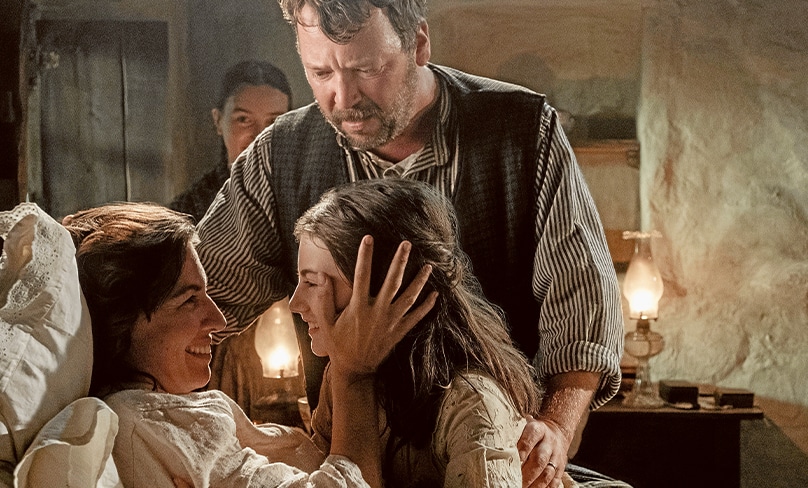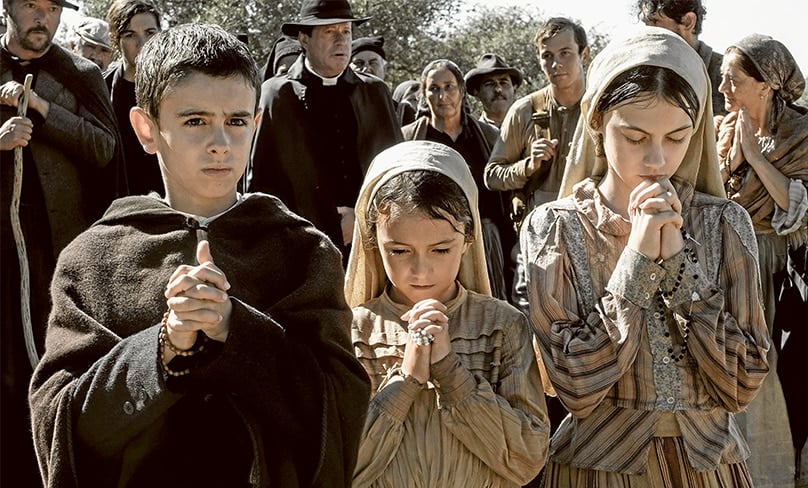
The 20th century was a dark period in history plagued by war, ravaged by revolution and marked by a growing rejection of God and all things true, good and beautiful.
By May 1917, the world was well on its way to self-destruction with the Great War (First World War) spreading unimaginable devastation across the European continent and radical ideologies drawing people further away from their faith.
In the midst of all this, in the small village of Fátima in Portugal, Our Lady chose to reveal herself to three small children with messages of prayer and penance urging humanity to turn back to God.
Though many films have been made about the miraculous events in Fátima, including the beloved The Miracle of Our Lady of Fátima (1952) and most recently The 13th Day (2009), none have captured its deeper meaning or examined the context of its occurrence as compellingly as Marco Pontecorvo’s Fátima, released by Picturehouse in theatres and on demand on 28 August.
Told from the point of view of Lucia Santos (now Servant of God Lucia and played by Stephanie Gil), the film follows the young shepherd girl in Fátima, Portugal, as she tries to support her struggling family by caring for their sheep with her cousins, Francisco (played by Jorge Lalemas) and Jacinta (played by Alejandra Howard).
Heading out with her herd to a place called Cova da Iria on 13 May, Lucia, Francisco and Jacinta are approached by a woman in white claiming to come from heaven.
The woman instructs the children to pray the Rosary every day for the world and asks them to return to the same place, each month, to meet her.
They obey and continue to meet her on each 13th day of the month to receive her messages about prayer, suffering, fasting and atonement to bring about peace.
As word on the visions spread, thousands flocked to Fátima in hope of meeting the seers and witnessing their encounter with the lady from heaven.
Unfortunately this attention, in a country focused on being progressive and enlightened, brought suffering and scandal to the children’s families as the secular government and church officials did their best to discredit the children and deter them from going back.
Events culminated on 13 October 1917 when the ‘woman from heaven’ revealed herself to the seers as the Lady of the Rosary before miraculously making the sun move and change colour as a sign for over 70,000 people to witness.
At certain points in the film, the story cuts to a much older Sr Lucia (played by Sonia Braga) in 1989 where she is being interviewed at her convent by a man named Professor Nichols (played by Harvey Keitel), a sceptic who is writing a book on apparitions.
From the opening scene, the film wastes little time in establishing its tone, pace and purpose as Lucia (played by Stephanie Gil) encounters the angel of Portugal who shows her a horrifying vision of the war and asks her to pray for peace.
The powerfully framed shots and beautifully captured expressions, made even more effective by the emotive score, strike at the heart and continue to do so up until the story’s final moments.
This film seamlessly uses warm and cool temperatures to differentiate between the two periods (1917 and 1989) and the array of brown and yellow tones against the sets and landscapes of early twentieth century Fátima are breathtaking.
Whether it’s sunlight illuminating the faces of the young seers in awe of their vision or shadows stirring suspense and fear that pierces the nerves, cinematographer Vincenzo Carpineta never misses a moment to engage the viewer with his remarkable use of lighting.
The stakes for the salvation of souls are high and it is clearly important to Pontecorvo that the audience feels the urgency for these apparitions throughout the hour and 53 minutes of running time.
Cleverly intertwining the destructive consequences of the war (both physical and ideological) into the lives of the Santos family, the film allows for audiences to witness the extent of suffering in the world while at the same time engaging with the main characters on a deep personal level.
As a result, one becomes invested in a narrative that is authentic, compelling and filled with meaningful experiences.
One criticism that must be made is the unnecessary use of cutaways to Sr Lucia and Professor Nichols’ interview in 1989.

Pontecorvo’s intention to connect the past to the present and to address some controversial questions of faith is noted but these scenes do more to hinder the experience than enrich it.
Having more to do with dialogue than delivery, Sonia Braga and Harvey Keitel join the rest of the cast in executing an outstanding and profound performance.
Without a doubt, the greatest performances come from the smallest actors.
Stephanie Gil, Jorge Lalemas and Alejandra Howard not only provide the audience with an emotionally satisfying portrayal of the three seers like none other before them, they succeed in embracing the traits unique to each child making their performances genuine.
Speaking as a member of a Portuguese migrant family, I think something can be said about the authenticity of the whole production.
Fátima was almost entirely shot on location in Portugal and the fruits of this decision is a film that feels absolutely real.
From the small stone houses to the elegantly embroidered fabrics and even the homemade bread in between, the designer’s attention to detail contributed greatly to bringing this story alive.
Fátima, rated M for mature themes and violence, will be released on demand from 28 August and will be shown at selected cinemas across the country.
Related articles:
